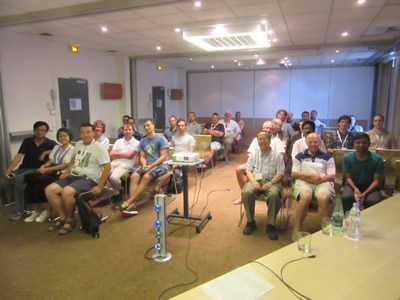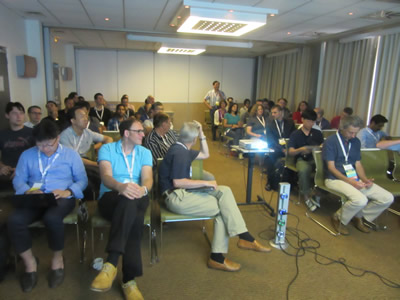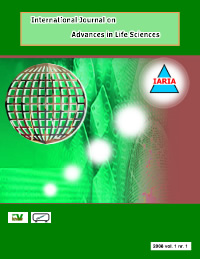eTELEMED 2021 - The Thirteenth International Conference on eHealth, Telemedicine, and Social Medicine
July 18, 2021 - July 22, 2021
eTELEMED 2021: Call for Papers
Onsite and Online Options: In order to accommodate a large number of situations, we are offering the option for either physical presence or virtual participation (pdf slides or pre-recorded videos).
We are facing the generalization of digital society across multiple social areas. The globalization imposes the revision of the health costs a society can support. The progress in difference domains, such as image processing, wireless communications, computer vision, cardiology, and information storage and management assure a virtual team to access online to the latest achievements.
Processing medical data benefits now from advanced techniques for color imaging, visualization of multi-dimensional projections, Internet imaging localization archiving as well as from a higher resolution of medical devices.
Collecting, storing, and handling patient data requires robust processing systems, safe communications and storage, and easy and authenticated online access.
We assist to a unprecedented and rapid deployment of use of electronic imagery, navigation portals, positive attitude on telemedicine, distributed surgery teams, tele-cardiology, and remote medicine. Development of wireless homecare, of special types of communications with patient data, of videoconferencing and telepresence, and the progress in image processing and date protection increased the eHealth applications and services, and extended Internet-based patient coverage areas. Social and economic aspects as well as the integration of classical systems with the telemedicine systems are still challenging issues.
There are several dedicated events on these topics, usually concentrated on local problems (national), or geographical areas (Europe, Americas), as social and governmental rules may differ; eTELEMED 2021 considers advances in techniques, services, and applications dedicated to a global approach of eHealth, including a regard on federated aspects considering the mobility of population, the cross-nations agreements, and the new information technology tools.
We solicit both academic, research, and industrial contributions. We welcome technical papers presenting research and practical results, position papers addressing the pros and cons of specific proposals, such as those being discussed in the standard fora or in industry consortia, survey papers addressing the key problems and solutions on any of the above topics short papers on work in progress, and panel proposals.
Industrial presentations are not subject to the format and content constraints of regular submissions. We expect short and long presentations that express industrial position and status.
Tutorials on specific related topics and panels on challenging areas are encouraged.
The topics suggested by the conference can be discussed in term of concepts, state of the art, research, standards, implementations, running experiments, applications, and industrial case studies. Authors are invited to submit complete unpublished papers, which are not under review in any other conference or journal in the following, but not limited to, topic areas.
All topics and submission formats are open to both research and industry contributions.
eTELEMED 2021 conference tracks:
eHealth-as-a-Service (eHaaS)
Globalizing health informatics; eHealth Web science; ePatient Reputation in Health Fora; Challenges for eHealth; eHealth-enabled Health; Nursing eChart; eLiteracy in healthcare; ePoint.telemed; Home monitoring on chronic diseases; Big Data and Smart Health; eHealth and education via visual analytics; Experiences in national eHealth systems; eHealth and medication-related services; TeleCare trials; Resource and demands through eHealth service; eHealth in critical situations (heart failure, kidney blockage, mental health, etc.); eHealth services and chronic diseases; User satisfaction with eHealth services; Patient acceptance of eHealth systems; eHealth and pharmaceutical systems; eHealth and nurse practitioners; eHealth Apps (1st aid, locating a hospital, etc.); eHealth and ePrescribing systems; Online eHealth communities; Context-aware eHealth systems; eHealth portals; eHealth Literacies
Focus on self-managing patients
Patient-empowerment services; Patient access to personal health records; Self-training systems; Web-based self-management; Chronic disease self-management; Hybrid nurses and self-managing systems; Dedicated self-management systems (diabetes, hearth, cancer, etc.); Self-management systems for impaired patients; Challenges with remote and rural communities; Community-based participatory medical decisions; Inappropriate prescriptions in self-management systems; Health consumer-centric perspectives; Medication self-managing
Focus on patient records
Usability of health data to benefit patient and public health safety, privacy and security; Integrating heterogeneous clinical data into central data warehouses; Patient safety at transitions of care; Patient safety in critical care units; Health care processes in the intensive care units; Nursing quality indicator systems; Patient safety event reporting systems; Patient online access to their electronic health records; Patient safety risks associated with electronic health records; Patient generated clinical data and associated implications for electronic health records; Electronic dental records systems; Model-driven for standardized electronic health records; Semantic interoperable electronic patient records; Ontological knowledge base for managing patient safety events; Validating the access to an electronic health record; User-composable electronic health records; Privacy in hospital information systems; Interconnection of electronic medical record with clinical data management systems; Integrated management of medical records; Integration of electronic health records into nursing education; Automating health monitoring in compliance with personal privacy; Medication safety with clinical decision support systems; User-driven privacy expectations from hospital information systems; Sharing patient profile information among medical institutions; Big data in medical informatics; Ontologies of causal epidemiological knowledge; Visualizing patient data; Biomedical datasets; Global patient-data exchanges; Challenges for patient-records standardizing
Rehabilitation robotics
Wearable robotic; Balance assessment robots; Robotically-assisted joints rehabilitation; Robotic hands; Post-traumatic robotics; Assistive robots for motion training; Pneumatic robotic assistance; Robot-assisted drinking and eating; Human-assistive robotic platforms; Exoskeleton-assisted walking; Massaging robots; Model predictive controllers; Cognitve interactions with assistive robots; Patient-assitance robotic-centered design; Accuracy and safety; Caregivers interaction with robotics
eHealth technology and devices
Telemedicine software and devices; Diagnostic/monitoring systems and devices; Electronic health cards; Home monitoring services and equipment; Telemedicine equipments; Online instruments supporting independent living; eHealth telecommunication services; eHealth wireless data communications; IPTV and/or phone portal clients; Standardised biomarker analysis for intrinsic linkage to disease outcomes
eHealth data records
eHealth medical records; Reengineering of care plans in electronic format; Digital imagery and films; Internet imaging localization and archiving; Personal, adaptive, and content-based image retrieval imaging; Privacy and accuracy communications of patient records; Secure patient data storage; Secure communications of patient data; Authenticated access to patient records; Patient privacy-enhancing technologies (PETs); Robust approaches to algorithmic modeling of outcomes; Dynamic graphing of individual’s data trends; Data aggregation technologies; Delivery of information governance policies; Tools/systems for automatic document metadata tagging; Dataset harmonization across multiple sites; Standard/symbolic representations of multiple physiological trends and clinical/life events
eHealth information processing
Web technology in medicine and eHealth; Web-enabled consumer-driven eHealth; Electronic imagery and visualization frameworks; Color imaging and multidimensional projections; Imaging interfaces and navigation; Medical image processing; Video techniques for medical images; Computer vision and resolution; Rapid evaluation of patient's status; Anticipative processing of patient's status; Videoconferencing; Telepresence
eHealth systems and communications
Hospital information systems; Internet/intranet services; Surgical systems; Sensor-based systems; Satellite eHealth communications; Secure data transmissions; Body-sensor networks; Separation of concerns between domain problems and technological choices; Service-Oriented Architecture (SOA) approaches to maximize translation of clinical evidence; Cross-border eHealth systems; HealthGrid; Wireless 'flooding' technology providing cheap e-health platform support to whole towns/cities
eHealth systems and emergency situations
Medical emergencies and communications; Detection emergencies situations; Medical resource allocation, optimization, and simulation; Real-time emergency situations management; Security and accuracy of emergency communications; Geolocalisation and optimization technology services for emergency fleet vehicles
Telemedicine/eHealth applications
Virtual telemedicine; Mobile eHealth services; Home monitoring and homecare applications; Wireless homecare; User-generated eHealth care; Personalized medicine; Wireless telemedicine ; Telehomecare technologies for the elderly; Automatic detection of infectious diseases
Telemedicine/eHealth services
Clinical telemedicine; Distributed surgery; Telemedicine and telehealth; Telepathology; Telecardiology; Telerehabilitation; Elderly and impaired patient services; Remote operational medicine; Remote consulting services; Telemedicare monitoring; Vital signs monitoring; Computer generated self care advice; Telemedicine handbag; Workflow approaches to improve healthcare intervention outcomes; Workflow to improve patient safety, decision support, and objective measurement of service quality; Support for evidence-driven integrated care pathways (ICP’s)
Sociological, sociotechnical and multi-disciplinary perspectives on eTELEMED practices
Social relations, structures and processes, and co-production of humans and technology in telemedicine and e-health services; New service models and co-production of relations, structures and processes; Human agency and macro conditions for telemedicine and innovation; Policies and practices of electronic health and patient records; Micro and macro relations and collaboration between professionals in new integrated care models; Gender, age, ethics and power in assisted living services and technologies.
Social and financial aspects
Safety in telemedicine; Business models; Cost-benefit studies; Legal and ethical aspects; On-line payment and reimbursement issues; Ambient Assisted Living; Shared-care systems for eHealth; Privacy in the eHealth systems; Multi-lingual eHealth systems; Continuity in eHealth care; System simulations for business case development and risk reduction; Problem-independent (generic application) eHealth architecture; 'Lean' e-health workflows; ‘Relative risk' dashboards - how the patient's condition 'sits' within population risk
Classical medicine and eHealth integration
Wide-area integration of eHealth systems; Current eHealth realizations and projects; Innovation in eHealth; Telemedicine portals; Standardization and interconnectivity of eHealth systems; Implementation of cross-border eHealth services; eHealth integration into routine medical practice; Affordable approaches to e-Health; eHealth acceptance with medical professionals and patients; Developing countries and eHealth; Distance education for eHealth; xHR standardization; Impact of ‘global’ integration standards and interoperability projects (e.g. CDA, IHE/XDS, SNOMED-CT, Continua Healthcare Alliance, IEEE11073, Common User Interface (CUI)
Preventive eHealth systems
Systematic risk analysis technologies for disease early detection and prevention; 'Patient path' hubs, mobile devices and/or dedicated home-based network computers; Information models for evaluation of disease progression risk/disease processes; Systems supporting quantitative healthcare (predictive outcomes) modeling; Health risk factor data collation and multiple longitudinal trend analyses; Support for disease prevention aimed at healthy individuals; Data aggregation and visualisation technologies for population-based reporting; 'Risk signature’ discovery to indicate optimal preventative or screening actions; Mapping SNOMED-CT terminologies to disease model archetypes; Quantitative individualized outcome risk analysis; Services for longitudinal data analysis/visualisation; Continuous workflow management across clinic, home and mobile locations
Challenges of large-scale, cost-effective eHealth systems
Integrated technology, social/behavioral and business modelling research for large-scale deployments; Total operational cost-effectiveness modelling; Lessons from large-scale telehealth/telecare demonstrators in different parts of the world; Standardised data collation infrastructures (data service layers); Impact of grid and service-oriented computing; Roles of global/international interoperability organisations (e.g. IHE and Continua); Scaleable multi-data trend management; Robust data collection along the ‘patient path’ for improved decision support; Delivery of ‘composite’ process functions (e.g. contributed by multiple vendor systems); Paths to semantically-harmonised eHealth systems; Semantic interoperability and openEHR archetypes; Applications of harmonised (standardised) datasets across multiple sites; Keeping technology simple and affordable
Nurse team applications
ePatient and eNurse tools that are simple to adopt and use; Public eHealth education & information; Life time health records; Primary care centers and home monitoring; Monitoring for signs and progression of complications; eHealth awareness, education and adoption; Mapping to individualized care plans; Continuous ‘closed loop’ outcomes analysis; Intervention measurement technologies; Personal target setting
Personalized eHealth
eHealth Systems in Mental Health; Preventive Systems and mobile activity monitoring; eHealth and life; Fundamentals in eHealth personalization; Wearable and implantable systems; Micro and nano eHealth sensors; Diagnostics using biosensors and textiles; Interacting with organic semiconductors; Personalized eHealth market; Personalized eHealth business models; Ubiquitous monitoring; Personalized eHealth and classical health networks; Trends in personalized eHealth; ICT solutions for patient self-management
Clinical telemedicine
Stroke (Acute stroke; Thrombolytic therapy; Transient ischemic attacks; Telestroke); Eplilepsy (Acute management of seizures, Follow-up strategies, management of complications); ICU (remote intubation, Management of acute respiratory distress); Cardiaology (EKG interpretation, Tele-Echo, Management of acute coronary syndromes); Pediatrics (Epilepsy, Cardiology-echo interpretation, Pediatrics emergencies)
Rural and wilderness eHealth
Rural health and eHealth programs; Rural medical practice; Healthcare challenges in rural areas; Provincial standards of emergency care; Diagnosing in rural areas; Wilderness emergency medicine; Developing and nurturing online communities for health; Rural self-health care
Environmental and travel telemedicine
Disease control and prevention; Geo-medical surveillance; Travel health-related products, drugs and vaccines; Altitude medicine; Oceanic medicine; Continuous monitoring of travelers' health; Self-health care
Deadlines:
Submission | May 11, 2021 |
Notification | Jun 02, 2021 |
Registration | Jun 13, 2021 |
Camera ready | Jun 16, 2021 |
Deadlines differ for special tracks. Please consult the conference home page for special tracks Call for Papers (if any).
INSTRUCTION FOR THE AUTHORS
Authors of selected papers will be invited to submit extended versions to one of the IARIA Journals.
Publisher: XPS (Xpert Publishing Services)
Archived: ThinkMindTM Digital Library (free access)
Prints available at Curran Associates, Inc.
How to submit to appropriate indexes.
Only .pdf or .doc files will be accepted for paper submission. All received submissions will be acknowledged via an automated system.
Contribution types
- regular papers [in the proceedings, digital library]
- short papers (work in progress) [in the proceedings, digital library]
- ideas: two pages [in the proceedings, digital library]
- extended abstracts: two pages [in the proceedings, digital library]
- posters: two pages [in the proceedings, digital library]
- posters: slide only [slide-deck posted on www.iaria.org]
- presentations: slide only [slide-deck posted on www.iaria.org]
- demos: two pages [posted on www.iaria.org]
FORMATS
Only .pdf or .doc files will be accepted for paper submission. All received submissions will be acknowledged via an automated system.
Final author manuscripts will be 8.5" x 11", not exceeding 6 pages; max 4 extra pages allowed at additional cost.
Helpful information for paper formatting for MS Word can be found here.
There is a community provided LaTeX template: the CTAN package iaria (with full IARIA formatting rules, including IARIA citation style, but for providing citation style it is tightly bound to pdflatex+biblatex+biber). In addition, there is also iaria-lite (not bound to pdflatex+biblatex+biber, but compatible with any TeX stack; thus, it cannot provide the IARIA citation formattings, but only the titlepage and content-related IARIA formatting rules). Based on the iaria package, there is a minimal working example as Overleaf template. When you are using the LaTeX templates, please still adhere to the additional editorial rules.
Slides-based contributions can use the corporate/university format and style.
Your paper should also comply with the additional editorial rules.
Once you receive the notification of contribution acceptance, you will be provided by the publisher an online author kit with all the steps an author needs to follow to submit the final version. The author kits URL will be included in the letter of acceptance.
We would recommend that you should not use too many extra pages, even if you can afford the extra fees. No more than 2 contributions per event are recommended, as each contribution must be separately registered and paid for. At least one author of each accepted paper must register to ensure that the paper will be included in the conference proceedings and in the digital library, or posted on the www.iaria.org (for slide-based contributions).
CONTRIBUTION TYPE
Regular Papers (up to 6-10 page article -6 pages covered the by regular registration; max 4 extra pages allowed at additional cost- ) (oral presentation)
These contributions could be academic or industrial research, survey, white, implementation-oriented, architecture-oriented, white papers, etc. They will be included in the proceedings, posted in the free-access ThinkMind digital library and sent for indexing. Please submit the contributions following the instructions for the regular submissions using the "Submit a Paper" button and selecting the appropriate contribution type. 12-14 presentation slides are suggested.
Short papers (work in progress) (up to 4 pages long) (oral presentation)
Work-in-progress contributions are welcome. These contributions represent partial achievements of longer-term projects. They could be academic or industrial research, survey, white, implementation-oriented, architecture-oriented, white papers, etc. Please submit the contributions following the instructions for the regular submissions using the "Submit a Paper" button and selecting the contribution type as work in progress. Contributors must follow the conference deadlines, describing early research and novel skeleton ideas in the areas of the conference topics. The work will be published in the conference proceedings, posted in the free-access ThinkMind digital library and sent for indexing. For more details, see the Work in Progress explanation page. 12-14 presentation slides are suggested.
Ideas contributions (2 pages long) (oral presentation)
This category is dedicated to new ideas in their very early stage. Idea contributions are expression of yet to be developed approaches, with pros/cons, not yet consolidated. Ideas contributions are intended for a debate and audience feedback. Please submit the contributions following the instructions for the regular submissions using the "Submit a Paper" button and selecting the contribution type as Idea. Contributors must follow the conference deadlines, describing early research and novel skeleton ideas in the areas of the conference topics. The work will be published in the conference proceedings, posted in the free-access ThinkMind digital library and sent for indexing. For more details, see the Ideas explanation page. 12-14 presentation slides are suggested.
Extended abstracts (2 pages long) (oral presentation)
Extended abstracts summarize a long potential publication with noticeable results. It is intended for sharing yet to be written, or further on intended for a journal publication. Please submit the contributions following the instructions for the regular submissions using the "Submit a Paper" button and selecting the contribution type as Extended abstract. Contributors must follow the conference deadlines, describing early research and novel skeleton ideas in the areas of the conference topics. The work will be published in the conference proceedings, posted in the free-access ThinkMind digital library and sent for indexing. 12-14 presentation slides are suggested.
Posters (paper-based, two pages long) (oral presentation)
Posters are intended for ongoing research projects, concrete realizations, or industrial applications/projects presentations. The poster may be presented during sessions reserved for posters, or mixed with presentation of articles of similar topic. A two-page paper summarizes a presentation intended to be a POSTER. This allows an author to summarize a series of results and expose them via a big number of figures, graphics and tables. Please submit the contributions following the instructions for the regular submissions using the "Submit a Paper" button and selecting the contribution type as Poster Two Pages. Contributors must follow the conference deadlines, describing early research and novel skeleton ideas in the areas of the conference topics. The work will be published in the conference proceedings, posted in the free-access ThinkMind digital library and sent for indexing. 8-10 presentation slides are suggested. Also a big Poster is suitable, used for live discussions with the attendees, in addition to the oral presentation.
Posters (slide-based, only) (oral presentation)
Posters are intended for ongoing research projects, concrete realizations, or industrial applications/projects presentations. The poster may be presented during sessions reserved for posters, or mixed with presentation of articles of similar topic. The slides must have comprehensive comments. This type of contribution only requires a 8-10 slide-deck. Please submit the contributions following the instructions for the regular submissions using the "Submit a Paper" button and selecting the contribution type as Poster (slide-only). The slide-deck will be posted, post-event, on www.iaria.org.
8-10 presentation slides are suggested. Also a big Poster is suitable, used for live discussions with the attendees, additionally to the oral presentation.
Presentations (slide-based, only) (oral presentation)
These contributions represent technical marketing/industrial/business/positioning presentations. This type of contribution only requires a 12-14 slide-deck. Please submit the contributions following the submission instructions by using the "Submit a Paper" button and selecting the contribution type as Presentation (slide-only). The slide-deck will be posted, post-event, on www.iaria.org.
12-14 presentation slides are suggested.
Demos (two pages) [posted on www.iaria.org]
Demos represent special contributions where a tool, an implementation of an application, or a freshly implemented system is presented in its alfa/beta version. It might also be intended for thsoe new application to gather the attendee opinion. A two-page summary for a demo is intended to be. It would be scheduled in special time spots, to ensure a maximum attendance from the participants. Please submit the contributions following the submission instructions by using the "Submit a Paper" button and selecting the contribution type as Demos. The Demos paper will be posted, post-event, on www.iaria.org.
Tutorial proposals
Tutorials provide overviews of current high interest topics. Proposals should be for 2-3 hour long. Proposals must contain the title, the summary of the content, and the biography of the presenter(s). The tutorial slide decks will be posted on the IARIA site.
Please send your proposals to tutorial proposal
Panel proposals
The organizers encourage scientists and industry leaders to organize dedicated panels dealing with controversial and challenging topics and paradigms. Panel moderators are asked to identify their guests and manage that their appropriate talk supports timely reach our deadlines. Moderators must specifically submit an official proposal, indicating their background, panelist names, their affiliation, the topic of the panel, as well as short biographies. The panel slide deck will be posted on the IARIA site.
Please send your proposals to panel proposal






































































